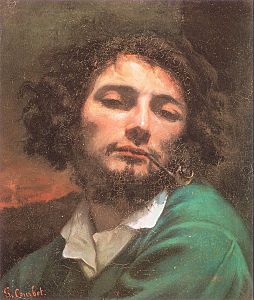
|
Courbet, a farmer's son, was born June 10, 1819, in Ornans. He went to Paris about 1840, ostensibly to study law; instead, he taught himself to paint by copying masterpieces in the Louvre, Paris. In 1850 he exhibited The Stone Breakers (1849, formerly Gem─ldegalerie, Dresden, destroyed 1945), a blunt, forthright depiction of laborers repairing a road. In it, Courbet deliberately flouted the precepts of the romanticsŚchampions of emotionally charged exoticismŚand of the powerful academicsŚguardians of the moralizing Beaux-Arts traditions. He further outraged them with his enormous Burial at OrnanÜ (1850, Mus╩e d'Orsay, Paris), in which a frieze of poorly clad peasants surrounds a yawning grave. Courbet compounded his defiance of convention in another huge painting, The Artist's Studio (1855, Mus╩e d'Orsay), which he subtitled A True Allegory Concerning Seven Years of My Artistic Life. In it, Courbet sits painting a landscape center stage, attended by a small boy, a dog, and a voluptuous female nude; at left a listless, bored group studiously ignores him; at right a lively, spirited crowd of his friends admires his work. At the same time he issued a provocative manifesto detailing his social realist credo of art and life. By this time he enjoyed widespread popularity.
By then Courbet's distinctive painting style was fully developed, marked by technical mastery, a bold and limited palette, compositional simplicity, strong and even harshly modeled figures (as in his nudes), and heavy impastoŚthick layers of paintŚoften applied with a palette knife (particularly evident in his landscape and marine paintings).
As radical in politics as he was in painting, Courbet was placed in charge of all art museums under the revolutionary 1871 Commune of Paris and saved the city's collections from looting mobs. Following the fall of the Commune, however, Courbet was accused of allowing the destruction of Napoleon's triumphal column in the Place VendĂme; he was imprisoned and condemned to pay for its reconstruction. He fled to Vevey, Switzerland, in 1873, where he continued to paint until his death on December 31, 1877.
|
